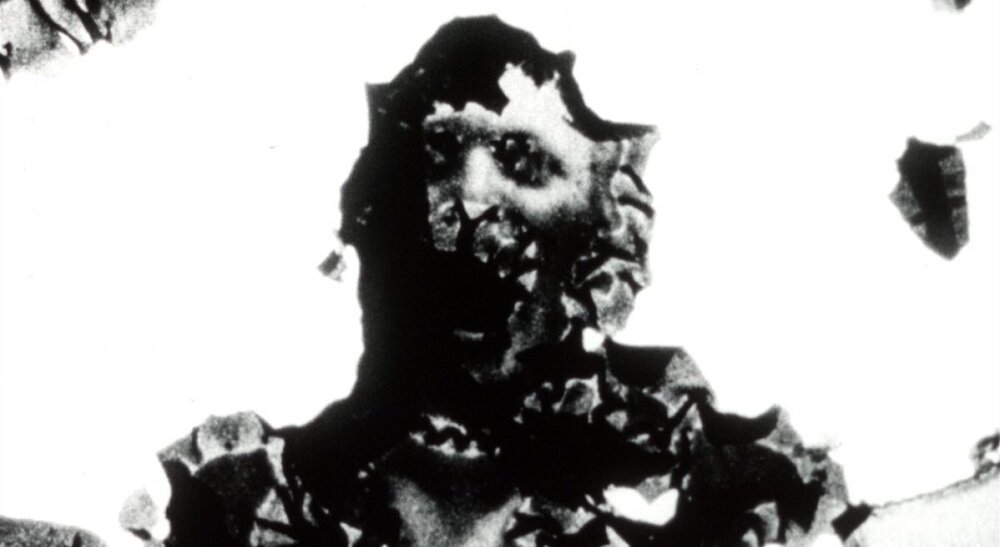The Canadian filmmaker talks re-filming old classics, Mordançage, and the power of cinema.
Potamkin (Stephen Broomer, 2017)
Stephen Broomer is a filmmaker, historian and preservationist based in Toronto. Broomer has led on the restoration of films by Canadian filmmakers such as John Hofsess, R. Bruce Elder, Arthur Lipsett, and Jim Smith while pursuing his own career in experimental filmmaking, often on 16mm. His first long film, Potamkin, was made in 2017 and takes as its basis the life and works of Harry Alan Potamkin who was a highly respected film critic and poet at the time of his death in 1933 at just 33 years old. Broomer’s film utilises found footage - taken from films that Potamkin himself reviewed - and warps and manipulates it into a disquieting and abstract blend of biography and treatise on the power of cinematic imagery.
On the event of ALT/KINO co-presenting the UK premiere of Potamkin with Edge of Frame at the 2019 London International Animation Festival, we had the opportunity to ask Stephen a few questions about how work.
ALT/KINO: Can you explain how you first came across Harry Alan Potamkin and what prompted you to make a film about him?
Stephen Broomer: I first encountered Harry Alan Potamkin as an undergraduate student at York University. I was studying filmmaking, and taking a film studies course. I can’t clearly remember the context in which I first read Potamkin - it may have been in a class in early cinema, or in film theory - and I only knew the name and a bit of his theory of the compound cinema. Later, I encountered his name again, twice, in the context of Kenneth Rexroth. I took many classes as a graduate student with R. Bruce Elder, who was also my doctoral supervisor, and he would often end courses with a reading of Kenneth Rexroth’s Thou Shalt Not Kill, a poem in which the question is asked, “what happened to Potamkin?” Rexroth also answered that question for me, in his essay “The Function of the Poet in Society,” where he talks about Potamkin as a poet of great value who died young in tragic circumstances. The circumstances of Potamkin’s death connect strongly to Rexroth’s overall sense of the murder of poets by society - one has to wonder if it was his experience of being around and knowing Potamkin, and being a witness to his funeral, that informed some of these convictions of Rexroth’s, in part, in part only insofar as Rexroth was a witness to so much pain in the house of poetry. So for me Potamkin is inspired by both Potamkin as a historical figure, film theorist, and poet, and by Rexroth, both as a poet and as a memoirist, or witness. For several years I had an interest in Potamkin as a possible subject for a film, and it was always clear to me in that time that the film would have to be a kind of experimental impression on his life. But what prompted me wasn’t just a sense of historical fascination. I was out of work; I had my filmmaking and my writing but few opportunities or pathways for survival. I felt like one those those names in Thou Shalt Not Kill… I carry that poem with me, timor mortis conturbat me. I think Thou Shalt Not Kill would give any viewer a sense of the feelings that had settled heavily on my heart at that time.
A/K: You mention Potamkin as a poet, in what ways did his poetry influence your construction of the film?
SB: The epigraphs at the top of each reel are from Potamkin’s poems. In Potamkin’s poetry we see a number of threads - Jewish mystical figures, commentary on race and labour, autobiographical leanings, and the modern difficulty of the Imagists - and those poems informed my process. I was searching passively for correlatives to Potamkin’s poems, images and strings of images that could suggest the forms of his poetry or that could reflect the content of his poetry. I was also immersed in Potamkin’s poetry at the time; through the course of making this film, I also made a book of Potamkin’s poetry which saw it collected for the first time, and also marked the first time any of it had been in print since 1933.
A/K: On to the film itself, can you speak a little about what was involved in the process of refilming and distorting the imagery - in particular, how did the analogue and digital processes you use combine?
SB: The imagery was taken from a mix of DVD, Blu-ray, and VHS copies of the source films. I rephotographed it to 16mm, black and white, high contrast film stock. This stock was then hand-processed, and exposed to a number of methods for film ‘destruction’ - methods that allow the emulsion to fade or melt away. The idea is that I initiate a destructive process using either chemistry or heat or force, and then I stop that process before it completely destroys the image. This gives a great deal over to chance. Some of this material was reworked using a JK optical printer, which would allow for changes of rhythm and superimpositions that are particular to that instrument. All of the material was then scanned, and worked over again using a computer. Some sequences were also rephotographed to film from this intermediate for one more round of chemical distress. But much of the work from that point on involved bringing the footage into a digital workflow, using non-linear editing tools like Adobe After Effects and Premiere to create sequences, and at times mirroring the operations of an optical printer. This was an act of reasserting control over all of the chance-driven chemical processes. At the very end of this process, it was photographed back to 16mm film for projection.
A/K: And was it always the intention for it to remain monochrome? You’ve applied a post chemistry colour palette to other films, such as Tondal’s Vision.
SB: Yes, I always intended it to be monochrome. I made Potamkin to be finished on film. I could only afford to make the film in black and white, and so the project suited my means well, in that the film would maintain an echo of the aesthetic of its sources. The film I made after it, Tondal’s Vision, is a tinted fantasy; that suited that film, and my work there was rooted in the colours of medieval illuminations. I regard Potamkin as a kind of silver tomb, an end-place for all the shadows of cinema that we generate in our perceptions and our writings and in all of that fragile, ephemeral culture and experience that springs up around cinema. That, to me, is quite separate from the silver vein of cinema, the life force, that common river of dreams that is above all resilient. Its shadows are not.
Potamkin (Stephen Broomer, 2017)
A/K: How did you go about choosing which films - and which parts of them - would serve as your source material?
SB: The films were easy to narrow down. I wanted to include a bit of every available film that Potamkin had written on. So there was no qualitative selection in that sense. I then looked for images that I found striking. He was writing in the transition between silent and sound film, so, much of what defined those years, especially on the ‘sound’ side, were films with a dull visual sensibility; in contrast there were also works by Pabst and Von Stroheim, which are the greatest looking films ever made. So I could then be qualitative by necessity: I could cut down using my own intuition to select, say, five minutes out of a two-hour film, and the five minutes I would select would not only be images I found strong but also images in which I could recognize a direct correlation to the life story of Potamkin - Potamkin who almost drowned as a boy, Potamkin whose father was a fish-seller, Potamkin who left a young wife in mourning, Potamkin the social worker whose visionary ‘creative workshops’ for children impressed upon many the importance of poetry and theatre in playtime. I could also recognize correlations with his poetry…“the louse in the beard of Jehovah…” And then, chance played its own hand in the process: I re-photographed many hours of films, and about third of them ended up disappearing in the soup, and about a third turned out in an unappealing way. The remainder became my material for the final film, and out of that certain motifs emerged.
A/K: Can you speak a little about your use of motifs - both as they specifically relate to Potamkin and also more broadly in your longer films?
SB: I have a real fascination with the development and restatement of themes. With few exceptions, each time a motif is used in one of these films, it is different. It may be different in some indiscernible way, but, sure enough, you won’t find the same frame repeated twice. With motifs I am establishing parameters for improvisation. Perhaps an image, or an image sequence, will repeat in some variation every three or four minutes; the region of the film that serves as a bridge between those variations is a playground. And by establishing motifs early, and feeling the flexibility to change them, or even to abandon them, I am able to surprise myself with the directions a work moves in. With Potamkin, there are a few motifs that have special significance: the rotating about-face crowd from Dovzhenko’s Earth; the fever-struck face from Pabst’s Westfront 1918; the lowering coffin from Griffith’s This Day and Age. I don’t assign these gestures a narrow meaning, but they have specific meaning to me. I leave it open because they may have different meanings for you, but also, because unassigned meaning empowers the viewer to connect these images. In this case, the relation of these three images is also caught up in Soviet montage, in the semiotic trap of Lev Kuleshov. But for me, motifs are also about keeping time, and they provide an undercurrent, a skeleton, for the rest of the images to tie together.
A/K: And, of course, there is the sequence from Battleship Potemkin which you replay and reconfigure extensively. At what point did this idea emerge and what was your thinking behind it?
SB: From the very start! I’ve encountered people who don’t get it, that it’s not just a weird joke. It’s a strange matter of fate that there would be this resonance between Potamkin’s name and the title of Eisenstein’s film. But more importantly, Potamkin’s theories of cinema are deeply connected to not only this film but this sequence; his sense of cinema as a dynamic, poetic force, and a force for social change, is most vividly realized by Eisenstein. The Odessa Steps sequence remains the most brutal rendering of oppression in all of cinema. Rexroth’s Thou Shalt Not Kill remains the most searing indictment of the murderers of poets and saints that has ever been written. There are parallels here between the cruelty Potamkin faced and the cruelties dealt by the Tsarists during the revolution… And so I see Potamkin’s fate, this sequence, and Potamkin’s theories of film as inseparable.
Stephen Broomer is filmmaker, preservationist, historian, educator, programmer and publisher. His films have screened at San Francisco Cinematheque's Crossroads Festival, the Toronto International Film Festival, S8 Mostra de Cinema Periférico (Galicia), and the New York Film Festival and he is author of several books including Codes for North: Foundations of the Canadian Avant-Garde Film (CFMDC, 2017). In 2020 Stephen is going to be a Fulbright Fellow at UC Santa Cruz.


